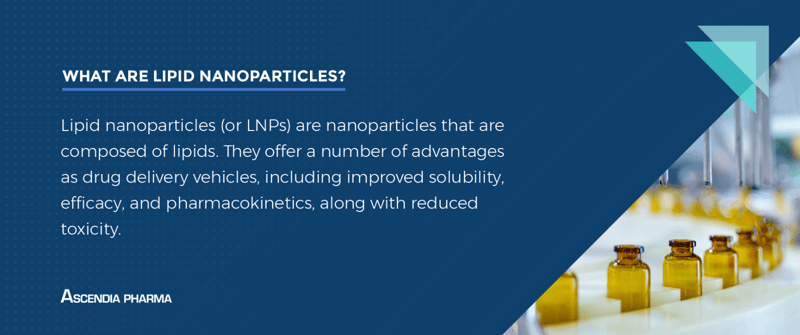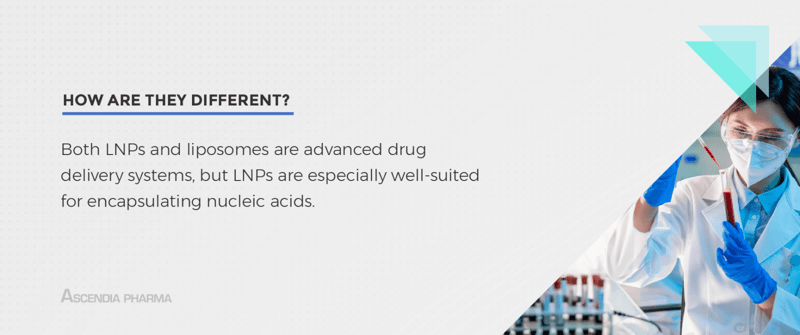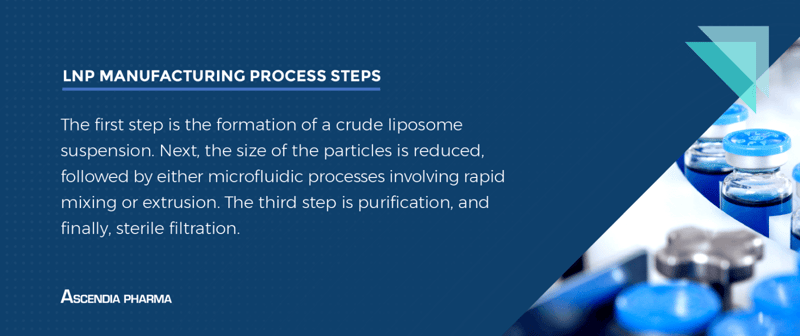Lipid Nanoparticle Formulation and Manufacturing
In this article, we’ll answer these questions and delve into the current state of lipid nanoparticle formulation and manufacturing in the pharmaceutical industry.
Lipid Nanoparticles Definition
What are lipid nanoparticles? Lipid nanoparticles are, as their name suggests, nanoparticles that are composed of lipids. Also known as LNPs, lipid nanoparticles for drug delivery were first approved in 2018. However, interest in this advanced drug delivery system increased in late 2020 when COVID-19 vaccines were introduced using LNPs to deliver mRNA strands into the body to produce immunity.
LNP formulations offer a number of advantages as drug delivery vehicles, including improved solubility (something especially significant with so many poorly soluble drugs in the clinical pipeline), efficacy, and pharmacokinetics along with reduced toxicity.

Types of Lipid Nanoparticles
Within the LNP category are two different types of lipid nanoparticles: solid lipid nanoparticles and nano-structured lipid carriers. Following is a quick rundown of each:
Solid Lipid Nanoparticles
Solid lipid nanoparticles (SLNs) overcome many of the challenges presented by other colloidal carriers, including liposomes, emulsions, and polymeric nanoparticles. They allow for targeted drug delivery, and they boast a good release profile and physical stability.
Solid lipid nanoparticles get their name from the fact that the lipids they’re formulated with are solid at body temperature. These lipids are stabilized by emulsifiers, and have a perfect crystalline structure. Unfortunately, this structure is also one of the drawbacks of SLNs: it means they have low drug loading efficiency, and during storage, they may suffer drug expulsion. SLNs also have an undesirable initial burst release.
Nano-Structured Lipid Carriers
Nano-structured lipid carriers (NLCs) are considered “next generation” lipid nanoparticles. They are a modification of solid lipid nanoparticles, with further improved stability and capacity loading. They are formed by combining solid and liquid lipids, and unlike the perfectly crystallized SLNs, NLCs have an unstructured matrix.
This unstructured matrix is what makes them an improvement over solid lipid nanoparticles. It’s what gives them a higher drug loading capacity. It’s also believed that this structure will help avoid drug expulsion during storage. In addition, NLCs increase drug solubility and offer a more controlled release.
Liposome vs. Lipid Nanoparticle
Liposomes and lipid nanoparticles are similar in that they’re both nano formulations, and both involve lipids. Each excels in delivering poorly water soluble drugs, and they protect their payloads with an outer bilayer of lipids.
So how are they different? Liposomes were an earlier version of lipid nanoparticles with a simpler structure. They continue to be used even as the next generation of lipid nanocarriers comes to the fore, as their unique vesicular structure means they can carry both hydrophilic and hydrophobic molecules, nucleic acids, and proteins, but their complex production methods make them more difficult to scale.
Lipid nanoparticles are liposome-like structures that have solid lipid bilayers. While liposomes have one or more rings of lipid bilayer surrounding an aqueous pocket, lipid nanoparticles typically have a single phospholipid outer layer to encapsulate the interior, which can be aqueous or non-aqueous.
Both LNPs and liposomes are advanced drug delivery systems, but LNPs are especially well-suited for encapsulating nucleic acids.

Lipid Nanoparticles Safety
The safety of lipid nanoparticles has come into the spotlight among consumers, particularly once COVID-19 vaccines that used mRNA lipids became widely available. Articles and social media posts talk about lipid nanoparticle dangers, and even lipid nanoparticle toxicity to humans and animals. As Science-Based Medicine puts it, “lipid nanoparticles are the new mercury” when it comes to vaccine hesitancy.
What we know from the robust body of research on using lipid nanoparticles for drug delivery is that, thanks to their ability to precision-target their payloads, lipid nanoparticle side effects have the potential to be less significant than side effects from conventional small molecule drugs. This is one of the key advantages of using LNPs for drug delivery. Lipid nanoparticle mRNA vaccines do not alter DNA, nor are mRNA-LNP adverse events all that different from traditional vaccines.
When it comes to delivering poorly soluble formulations for drugs and nucleic acids, liposomes and lipid nanoparticles have the ability to reduce the risk of severe adverse effects. Although LNP delivery is thought to be the culprit behind the achiness and malaise many people felt after their COVID-19 vaccinations, nex- generation LNPs are already being developed to overcome this, too.
The belief that this technology is somehow harmful is the opposite of everything we know about these drug delivery systems, and the effects they have had on the tens of millions of people who received COVID-19 vaccines.
Lipid Nanoparticle Formulation
Formulation of lipid nanoparticles is a rapidly developing field. Lipid nanoparticle-formulated drugs and vaccines with mRNA molecules are filling the drug development pipeline. As the pharmaceutical applications of lipid nanocarriers grow, so too will the number of methods available for formulating these nanostructures. A successful LNP formulation strategy requires a deep understanding of the options available.
The following LNP formulation methods are currently used for solid lipid nanoparticles and nano-structured lipid carriers:
-
High-Pressure Homogenization
There are two types of high-pressure homogenization (HPH): hot high-pressure homogenization and cold high-pressure homogenization. Hot HPH involves melting a lipid, then dissolving or dispersing the drug into it. A hot aqueous surfactant solution is added, then dispersed using a high shear mixing device. The pre-emulsion is homogenized until the desired particle size is reached, then the nano emulsion is cooled, allowing liquid droplets to crystallize and form LNPs with a solid matrix.
Cold high-pressure homogenization is similar, but after the melted lipid and drug are combined, the mixture is rapidly cooled with dry ice or liquid nitrogen. The cooled product is milled to microparticles, then homogenized to form lipid nanoparticles. -
Emulsification-Sonification
This method is similar to HPH, but after the drug-lipid melt is dispersed, a probe solicitor ultrasonicates the emulsion until the desired size of nanoparticles is reached. Lipid nanoparticles are formed once this emulsion is cooled to room temperature. -
Microemulsion
Microemulsions are used for solid lipid nanoparticles. The solid lipids are melted, the drug is dispersed into the lipids, then an aqueous surfactant-cosurfactant solution is added; the mixture is mildly agitated, which creates a microemulsion. This is dispersed in cold water with mild agitation and to form ultra-fine nanoemulsion droplets that crystallize to form SLNs. -
Solvent Emulsification-Evaporation
This is a method in which lipids are dissolved in an organic solvent, then emulsified in an aqueous phase that contains surfactants. The solvent evaporates, resulting in lipid precipitation. -
Solvent Diffusion
Solvent diffusion uses partially water-miscible organic solvents ; they are saturated with water to create thermodynamic equilibrium, then the oil-in-water emulsion is passed into water, solidifying the dispersed phase and forming lipid nanoparticles with the diffusion of the organic solvent. -
Solvent Injection
Solvent injection is similar to solvent diffusion, but once the lipids are dissolved in a water-miscible solvent or solvent mixture, they are injected into an aqueous solution of surfactants using a needle. -
Double emulsion
Double emulsion is used for the formation of lipid nanoparticles that are delivering hydrophilic drugs. The drug and a stabilizer are encapsulated in the inner aqueous phase of the double emulsion, then a stabilizer is added to keep the drug from moving to the outer aqueous phase when the solvent is evaporated. The resulting formulation has a larger particle size than most other SLNs, and is referred to as a liposphere.
Lipid Nanoparticle Manufacturing
Lipid nanoparticle manufacturing, like formulation, is also experiencing rapid growth as the demand for LNPs grows. Not all pharmaceutical companies and contract development and manufacturing organizations (CDMOs) have the equipment, knowledge, and team to handle LNP manufacturing. Certain specialty CDMOs have established manufacturing processes for LNP drug development.
There are four basic LNP manufacturing process steps, no matter the method or equipment used in production. The first step is the formation of a crude liposome suspension. Next, the size of the particles is reduced; size reduction can be achieved through solvent dilution, followed by either microfluidic processes involving rapid mixing or extrusion. The third step in the LNP manufacturing process is purification to remove the added solvents and any other impurities, and finally, sterile filtration is employed prior to aseptic filling.

Leading the Way in Lipid Nanoparticle Formulation and Manufacturing
Ascendia Pharmaceuticals is a leader in scalable LNP production. With our experienced team and advanced equipment, we’re a one-stop shop for lipid nanoparticle formulation and manufacturing. As a specialty CDMO, we can advance your drug through the entire development process, from formulation to clinical manufacturing. When you’re ready to scale and bring your drug to market, we’re ready, too.
We specialize in using nanotechnology solutions for low bioavailability and poorly soluble drugs, and we can perform nanoparticle formulations via bead-milling, microfluidization, and homogenization for both solid dosage forms or suspended for injection. Ascendia also has the ability to formulate self-emulsifying lipid systems, dispersed amorphous systems, and nano-emulsions to create any dosage form, including that can be administered orally, topically, inhalation, ocular or parenterally.

